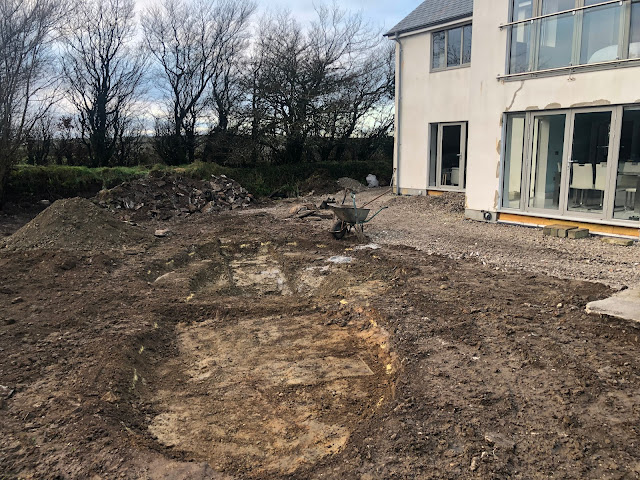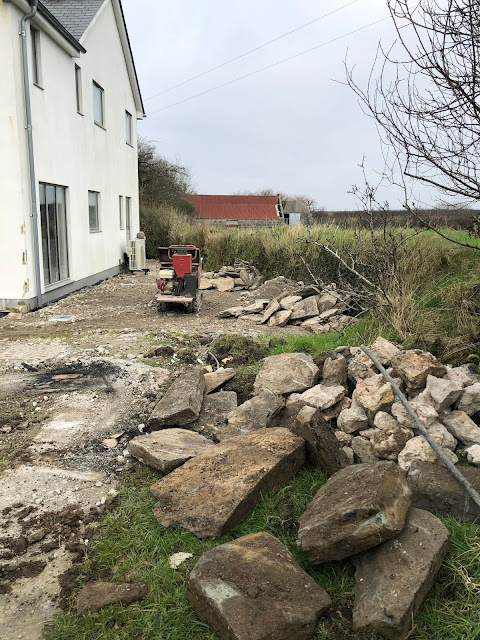For the first time since we bought the place, there wasn't any sign that a house had once stood in the back garden...
Before: mountains of crushed rubble, with more hardcore underneath...
With the rubble finally cleared and the site levelled around the house, the next job for the landscapers was the pond.
Months before the landscapers arrived on site, we'd agreed on a garden plan and budget.
We discussed our ideas with the landscapers and they based much of the design on the rough sketches that Vicky provided from her notebook.
The design went through several iterations... there was much more that we wanted to do, but were compromised by both the size and shape of the plot and were also heavily limited by our budget. (Garden landscaping is not cheap!)
The pond design also proved something of a compromise. We originally had two large ponds; a fish pond and a wildlife pond and had originally toyed with connecting 'streams', bridges and piers... though in the end, the budget forced us to scale back on our lofty ambitions.
We still managed to keep the two ponds, but now they would be joined together at slightly different levels, with a small waterfall in-between.
The basic outline for the pond was spray painted on the ground...
...and the digger was used to start the excavations. A laser level was employed to get the heights exactly right.
It's deeper than it looks in the photos. Viewed from above, the smaller, left-hand pond will be for wildlife, like newts, frogs, etc and the goldfish will be living in the larger pond on the right.
Once all the levels were correct, the landscapers sifted through the soil removing all the sharp stones they could find, then added a layer of sand over the whole thing to further protect the pond liner from getting ripped.
Once the whole thing had been covered in sand, the pond liner was then laid over the top.
To push the liner down into place, the pond was filled with some water.
Unfortunately, within a few hours, the water had started going brown...
... and a closer look revealed the tell-tale oily marks on the surface which showed the filtering for our private water supply was failing. Our water was full of iron (brown) and manganese (oily).
It was fixable, but we could do without having to pay for expensive water filtration repairs while already paying for the landscaping.
We had saved piles of slate from the foundations and fireplace of the old house and the landscapers used a lot of these to construct the new pond. This would help save us money and once again seemed rather fitting that parts of the old house would be recycled for the new one.
Building the waterfall between the two ponds. The pond pump and pipework was all hidden behind the slate as it was constructed.
Once all the slates had been positioned in the two ponds, the gaps were filled with 20mm golden gravel. At the last minute, we also took the opportunity to fit some underwater pond lights so that all the wiring could be concealed neatly in ducting under the slate.
In the garden plan, the large pond filter was supposed to have been sited in the corner of the garden where it couldn't be seen, but for some reason the landscapers decided to move it closer to the pond. We weren't sure if this was for functional reasons or down to 'lazyitis', but it was a bit of a bone of contention as it just looked ugly sticking out of the ground. The landscapers claimed that they would disguise it, but we weren't convinced.
The overlapping edge of the liner was cut back, buried slightly in the ground then concealed using large slates positioned around the perimeter of the pond.

We asked for two gently-sloping 'beaches' to be created - one at the end of each pond - in order to allow small animals and birds to be able to drink or wash safely.
Before the fish could move in to their new home, the pond would need to be 'conditioned'. It needed time to develop beneficial bacteria that will help keep the water free of dangerous compounds like ammonia, so we filled it with water, switched on the pumps and just left it gently trickling for the next few weeks.
Despite the fact that we hadn't done any planting around the pond yet, it was fantastic to see the local birds using it within a few days. One of our first visitors was this pied wagtail who enjoyed regular baths in the wildlife pond.
The natural slope of the land meant that we didn't site the pond where the landscapers had originally planned. We were really pleased about that, because the new position brought it into a more central position in the garden and closer to the house, so that we will be able to look right down into the fish pond from the balcony in the main bedroom.
Still more building site than garden... the fish wouldn't be moving in for several weeks and there was a lot more work to do around the pond first.


































































